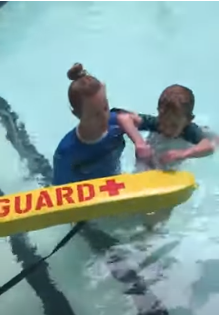Familiarizing Children with Rescue Equipment in Aquatic Settings
Promoting Water Safety for Special Needs
In the realm of aquatic activities, water safety is paramount, especially when it concerns children, particularly those with special needs. It is of crucial importance to familiarize children, including those with autism and other disabilities, with rescue equipment in aquatic settings. In the video below by Swim Angelfish, Global Leaders in Adaptive Aquatics, you will find an explore the fundamental reasons behind this initiative, and how it can provide not only a sense of security but also an opportunity for these children to embrace the joys of water in a safe and therapeutic environment.
 |
| Water Safety For Special Needs Children |
Safety for Children with Autism
The first and foremost point to address is the safety of children with autism. These children may have unique challenges when it comes to understanding and adhering to safety measures around water. The video below underscores the necessity of teaching safe behaviours in the pool and the significance of rescue equipment in ensuring a secure swimming environment.
For children with autism, predictability is key. They often thrive in environments that offer structure and routine. The presence of rescue equipment, such as life jackets and flotation devices, provides an added layer of security, creating a familiar and reassuring environment.
Overcoming Fear of Water
Many children, regardless of their abilities, harbour a fear of water. It's a common challenge that can be especially pronounced in children with special needs. The video discusses how introducing rescue equipment plays a pivotal role in helping these children overcome their fear of water.
By equipping children with the tools they need to stay afloat and feel safe, they gradually build confidence in the aquatic environment. The process is not just about teaching them to swim but helping them develop a positive relationship with water, free from anxiety and apprehension.
Importance of Aquatic Therapy
A cornerstone of this initiative is the recognition of aquatic therapy as a powerful tool for children with special needs. Aquatic therapy, often overlooked, can significantly improve self-regulation, particularly for children with autism. It provides a therapeutic environment that is both nurturing and supportive.
The video reminds us that aquatic therapy is not just about physical exercise; it is a holistic approach to development. By incorporating rescue equipment into aquatic therapy sessions, children can experience a sense of safety and support, further enhancing their overall well-being.
Adaptive Aquatic Tips
Don't merely promote the use of rescue equipment. But offer practical advice for swimmers with various abilities, including physical limitations, Down syndrome, and sensory processing disorders. This makes aquatic activities more accessible and enjoyable while maintaining a strong focus on safety. It also opens the door to a world where aquatic activities can be both fun and therapeutic for children with special needs.
Preparing for Special Olympics
Never let presumption limit a swimmer's development. The transformative power of a well developed aquatic program opens the door for an inspiring journey of an autistic swimmer to progressed from adaptive swim lessons to participating in the Special Olympics.
The Special Olympics is a testament to what dedication, support, and the right equipment can achieve. It exemplifies the incredible potential within every child, regardless of their abilities, and underscores the significance of creating safe and inclusive aquatic environments.
Teaching Butterfly Stroke
Swimming is not a one-size-fits-all activity, especially when it comes to children with special needs. By understanding their unique challenges and adapting teaching methods, we can help them master swimming techniques, building their confidence and water safety skills simultaneously.
Immediate Safety Routine
For children with autism, an immediate safety routine can make all the difference. This routine provides additional time for redirection if necessary, helping maintain safety during aquatic activities.
By incorporating a structured safety routine, children can better understand the expectations and rules of the aquatic environment. This not only keeps them safe but also enhances their overall experience in the water.
Familiarizing children, especially those with special needs, with rescue equipment in aquatic settings, is more than just a safety measure; it is a gateway to a world of possibilities. It offers a sense of security, a way to overcome fears, and a path to inclusive and therapeutic aquatic experiences. By embracing the principles highlighted in this article, we can ensure that children with special needs can fully enjoy the wonders of water, all while staying safe and secure.
Enjoy
Richard








No comments:
Post a Comment